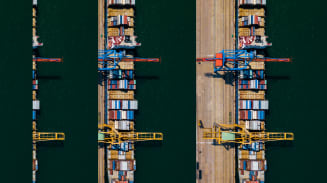3.1%
Global growth is projected to be 3.1 percent in 2024, up from its 2023 projection of 2.9 percent.
Source: The World Trade Organization

Trade is the lifeblood of the global economy. But due to its breadth and scope, it unsurprisingly faces several significant challenges — often interconnected and mutually reinforcing — including geopolitical instability, inflation, climate change, currency fluctuations and people availability. Together, these create a complex and volatile global trade landscape for business leaders to navigate.
All of the top 10 risks identified by business leaders in Aon’s latest Global Risk Management Survey have implications for global trade, with six directly linked:
Geopolitical instability is a top concern for businesses. We have seen its impact in recent months in the Middle East and — over a longer period — in Ukraine. Trade between geopolitically distant economies accounts for nearly 20 percent of global goods trade, but close to 40 percent of trade in globally concentrated products.1
“Geopolitical issues remain the primary issue in our global supply chain,” says Global Risk Consulting Leader Richard Waterer. “They’re reshaping trade channels, resulting in less availability of certain products and commodities. This causes price increases and is central to significant global tension.”
The Suez Canal — at the neck of the Red Sea — is used by roughly a third of global cargo vessels. But following attacks by Yemen’s Houthis, linked to the war in Gaza, average worldwide costs to ship a 40-foot container have doubled2 as ships, which traditionally took the Red Sea-Suez Canal route, have opted to traverse around Africa. This detour adds an additional two weeks to the journey, resulting in higher fuel and labor costs — which are ultimately passed on to the business and consumers.3 It is clear that the rerouting of shipping lanes has the potential for far-reaching consequences beyond the immediate locations affected.
The number of new global trade restrictions has also steadily increased year-on-year. There were more than 3,000 new restrictions in 2023, up from about 650 restrictions introduced in 2017.4
Global growth is projected to be 3.1 percent in 2024, up from its 2023 projection of 2.9 percent.
Source: The World Trade Organization

Case Study
As issues in the Red Sea continue to impact global shipping, many insurers have canceled war and strikes coverage under their marine cargo policies. The loss of this cover has created a significant protection gap for traders and intensifies concerns about maritime travel through the Red Sea trade route.
In response, Aon worked closely with Lloyd’s to create a special risk facility for smaller cargo war risks in the Red Sea. The cargo risk facility is written with Lloyd’s capacity and enables small and mid-size traders in the Dutch market to quickly access war coverage for shipments through the Red Sea. Risks are bundled into one facility, which enables traders to pay premiums as much as 50 percent lower than what they would have paid individually.
Meanwhile, climate obligations are an increasing focus for businesses moving goods and commodities globally. Maritime regulation introduced in 2020 requires ship owners and operators to decrease sulfur emissions by 85 percent. New cleaner fuel can be over 25 percent more expensive, representing a direct financial impact on businesses’ bottom line.5 The combination of new regulations and heightened stakeholder scrutiny has the potential to create new reputational exposures and financial impacts — issues that are expected to deepen as businesses look to tackle the climate crisis.
"The intersection of supply chain and reputational risks has created a perfect storm that poses a potential threat to both an organization’s profitability and brand equity,” says Ladd Muzzy, Global Reputation Risk Practice Leader. “Quantifying the reputation exposure has been a keystone to better business decisions.”
Supply chain risk is complex, multi-faceted and costly, with disruptions significantly impacting both business and financial performance.
Looking ahead, organizations need to consider enterprise risks associated with their supplier location strategy, including political risk and terrorism, corruption and bribery, and risks associated with weak legal and regulatory controls.
Geopolitical risks will remain a significant concern for international business, especially where they are reliant on supply chains with exposures to volatile regions and sea lanes.
“Geopolitical tensions linked to issues, such as the busiest election year on record, are pressing concerns for business leaders and the insurance market,” says John Minor, Director of Crisis Management and Political Risk. “They have the potential to complicate supply chains for many clients. Navigating capacity challenges will drive risk managers to be more strategic as we approach the insurance markets from a supply chain perspective.”

2024 Client Trends Report
In addition to the movement of goods and commodities, the role of mergers and acquisitions (M&A) is significant in shaping the landscape for global trade. M&A dealmakers see potential in the global economy in the coming years, but maintain a close eye on an increasingly interconnected risk landscape.
According to Aon’s Global Risk Management Survey, dealmakers and risk managers consider the top five financial risks to be:
Each risk intersects, amplifying the threats financiers face.
Macroeconomic volatility and increasingly complex regulatory regimes have affected M&A market dynamics over the past two years. Access to capital has become increasingly challenging, with elevated interest rates making the cost of borrowing more expensive.
In response, some dealmakers explored alternative sources of capital, while others paused transactional activity until economic volatility begins to smooth. This led to a deal volume decline of 11 percent in the first half of 2023, down 35 percent against 2021 highs, according to Aon’s M&A 2023 Risk in Review.
Despite these numbers, change and optimism are in the air in 2024. “Macro factors are indeed squeezing clients and creating headwinds for M&A,” says Gary Blitz, Co-CEO for M&A Transaction Services. “But over the last three to six months, we've been seeing the market rebound as the volatility coming from those factors subsides.” This should bode well for broader trade dynamics.
Alongside the financial and operational impacts of macroeconomic volatility, environmental social and governance (ESG) pressures are a focus for dealmakers globally. It is not just a responsible choice, but a strategic imperative. From attracting investors and consumers, to fostering employee engagement and securing regulatory compliance, embracing ESG principles has become integral for forward-thinking businesses.
ESG obligations and robust governance reporting directly impact company valuations and deal appetite, but dealmakers are reporting the quality of ESG information is not always up to the desired standard currently.
As multinational M&A deals and supply chains extend across multiple regions, assessing social risks, such as a country’s human rights record, is now a business imperative from both an ethical and regulatory standpoint.
“Because ESG means different things to different stakeholders, and because regional and industry nuances matter, there is not a one-size-fits-all approach to ESG-related categories. This is especially true in the impact of ESG on valuations or risk assessments by financial stakeholders,” says Kelsey Owen, Partner of Talent Solutions, North America.
Global growth is projected at 3.1 percent in 2024, up 0.2 percent from October 2023, according to the World Economic Outlook.6 Inflation is also falling faster than expected in most regions — down to 5.8 percent in 2024 and predicted to reach 4.4 percent in 2025. The likelihood of a hard economic landing is receding, and risks to global growth are broadly balanced.
As such, the key word in M&A — and trade more broadly — is stability, which the global economy appears to be delivering to dealmakers as we move deeper into 2024.
To prepare, executives should embrace deeper due diligence efforts across key risk areas, including cyber security and workforce resilience. They should also develop a robust risk transfer strategy that leverages transaction insurance capital to de-risk transactions.
“Peculiarly, the general view that inflation has peaked and is only going to go one way may increase volatility as people wait to do deals to see if they get a cheaper cost of money,” says Alistair Lester, Co-CEO, M&A Transaction Services.
Despite evolving risks, deals are providing opportunities to invest in digital and ESG-friendly capabilities, which are helping to bolster dealmaking prospects in several sectors, including telecommunications and digital technologies, industrials and chemicals and renewable energies.
Dealmakers will need to navigate higher expectations from regulators, who are demanding greater transparency regarding how ESG factors are considered in the investment process. Investors, too, are raising the bar and demanding disclosure of more granular ESG information than ever before. Ninety-six percent of dealmakers surveyed in Aon’s recent M&A Risk in Review expect ESG scrutiny in deals to increase over the next three years, while 24 percent now say environmental litigation is their most pressing ESG concern. Prudent investors who capitalize on current conditions and stay ahead of developing trends will find pathways to success.
“The Inflation Reduction Act is creating a lot of M&A deal flow in the U.S., tax investing and opportunities in renewable energy and infrastructure projects,” adds Blitz. Sixty-eight percent of dealmakers expect the expanded tax incentives under the IRA to drive global investment in U.S. disproportionately to the rest of the world to a high or moderate degree. “We’re actively helping investors and the buyers protect themselves in those deals. An ESG mindset is driving a lot of appetite, in addition to the beneficial tax credits.”
The climate imperative will continue to guide leaders’ trade decisions. ESG obligations, increasing stakeholder scrutiny and evolving regulations will create focus and impetus for the global M&A market.
There are three opportunities businesses need to consider when navigating global trade risks.

Building visibility into the supply chain is the cornerstone of mitigating risk. A single strategy for supply chain risk is about a single version of the truth — a taxonomy of supply chain issues that the firm agrees they face consistently and, most importantly, a singular understanding of possible outcomes.
Harnessing data and analytics to build transparency around your most important suppliers, their geographic location and their dependency on third parties will be critical as risks evolve. Awareness of the costs of supply chain failures will help leaders take proactive steps to invest in mitigating existing risks and their potential impact.
“From a risk strategy point of view, it starts with an understanding of where the risk is in the supply chain and quantifying it,” says Waterer. “If you have a picture of your top risks and an understanding of your level of exposure, that will frame the decisions that you want to make as an organization, informing an appropriate balance of risk and reward.”
While the economic outlook can impact when and how businesses exercise their capital, whether through internal investments — such as risk management — or external transactions — such as M&A activities — data and analytics will remain the bedrock of better decisions. We have seen this help in three scenarios:
“Supply chain risk management should be truly enterprise-wide, connecting risk and insurance professionals with senior directors in supply chain, procurement, treasury, strategy and operations, around a common set of data and decision making,” says Derrick Oracki, Managing Director and Actuary in Aon’s Global Risk Consulting practice.
Specialist solutions are critical in helping organizations navigate volatility and mitigate the risks inherent in trade through supply chain risk management. They can also help facilitate the pursuit of complex M&A transactions. Data-driven insights allow leaders to make informed decisions about material risks and how to address potential exposures.
“The thesis in our world now is that we can solve for identified risks through insurance transfer,” adds Lester. “A question I am hearing from clients is: how insurance solutions can help box away a risk we are concerned about in a way that allows us to get a deal done.”
In response, supply chains may shorten as more businesses consider the use of nearshoring as an operational strategy to overcome evolving supply chain risks. Data will be central to decision-making. Improved insights around where, and how, risk impacts the supply chain can help inform business leaders as they prepare for unplanned events and volatile supplier performance.
Aon's Capabilities:

2024 Client Trends Report
Every global business is navigating an increasingly complex and volatile trade landscape, making it harder to grow and maintain operational resilience.
Risk analytics allow organizations to identify emerging challenges and new opportunities for transformation.
Aon’s risk management and risk financing teams use analytics to give leaders and risk managers the insights they need to make better decisions on managing the total cost of risk and implementing effective trade risk mitigation strategies via tools that include:
In today’s volatile environment, organizations must navigate an increasing number of interconnected risks while making decisions that impact their customers, employees and balance sheet.
Aon’s Global Crisis Solutions team helps businesses prepare for crisis events by providing consultative risk mitigation and placement strategies. This, combined with crisis response expertise, helps enhance clients’ ability to prepare for, navigate and respond to a crisis, while minimizing organizational disruption and damage.
Aon addresses risk in the following areas, providing local guidance where appropriate:
Change is in the air for M&A dealmakers. Volatility driven by macroeconomic, regulatory and geopolitical headwinds — among others — is beginning to subside, giving the M&A market cause for future optimism.
As the M&A market gains momentum, dealmakers will need specialist partners who understand their goals and bring robust knowledge of deal sourcing, transaction processes, risk management and investment strategies to the table.
Aon provides specialist solutions and capabilities across the entire deal lifecycle to deliver optimal deal and business outcomes:
Businesses are facing a myriad of economic challenges as new forms of volatility impede business operations and change consumer and employee expectations:
Leaders can secure an edge over competitors by leveraging comprehensive credit solutions. Using a triple-pronged approach of credit insurance, political risk insurance and surety services, Aon can help businesses unlock capital while developing sustainable growth strategies.
1 Geopolitics and the geometry of global trade | McKinsey
2 Importers Face Surging Shipping Costs, Delays as Red Sea Diversions Pile Up - WSJ
3 Shipping Costs Soar in Wake of Red Sea Attacks - The New York Times (nytimes.com)
4 Geopolitics and the geometry of global trade | McKinsey
5 How can fuel insurance support companies’ transition to cleaner fuels?
6 World Economic Outlook Update: Moderating Inflation and Steady Growth Open Path to Soft Landing
General Disclaimer
This document is not intended to address any specific situation or to provide legal, regulatory, financial, or other advice. While care has been taken in the production of this document, Aon does not warrant, represent or guarantee the accuracy, adequacy, completeness or fitness for any purpose of the document or any part of it and can accept no liability for any loss incurred in any way by any person who may rely on it. Any recipient shall be responsible for the use to which it puts this document. This document has been compiled using information available to us up to its date of publication and is subject to any qualifications made in the document.
Terms of Use
The contents herein may not be reproduced, reused, reprinted or redistributed without the expressed written consent of Aon, unless otherwise authorized by Aon. To use information contained herein, please write to our team.
Our Better Being podcast series, hosted by Aon Chief Wellbeing Officer Rachel Fellowes, explores wellbeing strategies and resilience. This season we cover human sustainability, kindness in the workplace, how to measure wellbeing, managing grief and more.
Stay in the loop on today's most pressing cyber security matters.
Our Cyber Resilience collection gives you access to Aon’s latest insights on the evolving landscape of cyber threats and risk mitigation measures. Reach out to our experts to discuss how to make the right decisions to strengthen your organization’s cyber resilience.
Our Employee Wellbeing collection gives you access to the latest insights from Aon's human capital team. You can also reach out to the team at any time for assistance with your employee wellbeing needs.
Explore Aon's latest environmental social and governance (ESG) insights.
Our Global Insurance Market Insights highlight insurance market trends across pricing, capacity, underwriting, limits, deductibles and coverages.
How do the top risks on business leaders’ minds differ by region and how can these risks be mitigated? Explore the regional results to learn more.
Our Human Capital Analytics collection gives you access to the latest insights from Aon's human capital team. Contact us to learn how Aon’s analytics capabilities helps organizations make better workforce decisions.
Explore our hand-picked insights for human resources professionals.
Our Workforce Collection provides access to the latest insights from Aon’s Human Capital team on topics ranging from health and benefits, retirement and talent practices. You can reach out to our team at any time to learn how we can help address emerging workforce challenges.
Our Mergers and Acquisitions (M&A) collection gives you access to the latest insights from Aon's thought leaders to help dealmakers make better decisions. Explore our latest insights and reach out to the team at any time for assistance with transaction challenges and opportunities.
How do businesses navigate their way through new forms of volatility and make decisions that protect and grow their organizations?
Our Parametric Insurance Collection provides ways your organization can benefit from this simple, straightforward and fast-paying risk transfer solution. Reach out to learn how we can help you make better decisions to manage your catastrophe exposures and near-term volatility.
Our Property Risk Management collection gives you access to the latest insights from Aon's thought leaders to help organizations make better decisions. Explore our latest insights to learn how your organization can benefit from property risk management.
Our Technology Collection provides access to the latest insights from Aon's thought leaders on navigating the evolving risks and opportunities of technology. Reach out to the team to learn how we can help you use technology to make better decisions for the future.
Trade, technology, weather and workforce stability are the central forces in today’s risk landscape.
Our Trade Collection gives you access to the latest insights from Aon's thought leaders on navigating the evolving risks and opportunities for international business. Reach out to our team to understand how to make better decisions around macro trends and why they matter to businesses.
With a changing climate, organizations in all sectors will need to protect their people and physical assets, reduce their carbon footprint, and invest in new solutions to thrive. Our Weather Collection provides you with critical insights to be prepared.
Our Workforce Resilience collection gives you access to the latest insights from Aon's Human Capital team. You can reach out to the team at any time for questions about how we can assess gaps and help build a more resilience workforce.